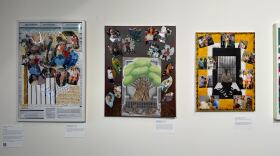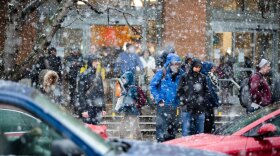Eighty years ago, Executive Order 9066 sent over 100,000 Japanese and Japanese Americans to incarceration camps during World War II. Most families lost their property and land during this time, including the Nikkei farmers of Bellevue.
Michelle Kumata is a local Japanese American artist who worked with the Bellevue Arts Museum and Meta Open Arts to create an installation honoring these farmers.
The first thing you’ll see when you enter the museum's lobby is a tiny replica of a farmhouse. Its walls are covered in a dark navy blue with cranes mid-flight. Featured against the backdrop are yellow faces of actual Nikkei farmers from Bellevue who were incarcerated. Each person's clothes have different stamps on them to represent their stories. For example, on Kiyo Yabuki's shirt are stamps of Purple Hearts representing his time in the military during the war and postmarks because, after he returned from the camp, he was the first person of color hired at the Bellevue Post Office.

"So many of these stories of incarceration are lost and will be lost with this older generation," Kumata said. "I feel like the farmhouse is kind of like a container for the stories and experiences."
Three of the four sides of the farmhouse have a QR code on them. Visitors can scan them with their smartphones which will bring them to an animation of one of the faces in the mural. The voice you hear is from the actual person.
Kumata spent time doing extensive research and used the Densho Archive to find oral interviews to use in the animation. One of the farmers who is depicted and who you can hear from is Rae Matsuoka Takekawa. She recalls the time during the war.

“My mother always grew flowers, and there was also an orchard. When the war broke out, the FBI came for my dad that night, the morning of December 8,” Takekawa says in the animation.
Kumata's work focuses on the Japanese diaspora and is heavily influenced by her heritage. Her work that explores the Japanese incarceration during World War II is particularly personal. Both of her parents were born in a camp in Minidoka, Idaho. Growing up, she never learned much about their time there. She hopes, though, that this installation will help this part of history live on and for others to embrace their Japanese heritage.
"I hope that younger Japanese Americans feel that way and can feel proud of their history and heritage and not have to apologize for who they are," Kumata said.
The Bellevue Arts Museum is hosting a free virtual event Saturday to honor the Nikkei farmers and mark the 80th anniversary of Executive Order 9066.







